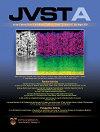Role of a surface hydroxyl group depending on growth temperature in atomic layer deposition of ternary oxides
IF 2.1
3区 材料科学
Q3 MATERIALS SCIENCE, COATINGS & FILMS
引用次数: 0
Abstract
Atomic layer deposition (ALD) of multicomponent materials is challenging because the growth characteristics often deviate from what is expected due to the difference in surface characteristics of heterogeneous and single materials, resulting in undesired thickness or properties. For metal oxides, the growth characteristics highly rely on the surface hydroxyl groups, which play a role as the reactive site. Thus, studying the reaction mechanism of a precursor on hydroxyl-terminated heterogeneous surfaces is important for understanding the nonideal growth of ternary oxide. Here, we investigated the correlation between hydroxyl and the growth of ALD TiSiOx depending on temperature, analyzing infrared spectra, and chemical compositions. The results show that large amounts of hydroxyl are detected in TiSiOx deposited at 100 °C, where the adsorption of H2O on Ti–O–Si bonds is favorable. It leads to higher growth per cycle (GPC) than the estimated value. In contrast, the hydroxyl disappears at 200 °C due to dehydroxylation, resulting in lower GPC. Differences in hydroxyl also influence the film density as revealed in x-ray reflection spectra, which is related to the film qualities (e.g., elastic modulus and dry etch rates). This work provides insight into how to control hydroxyl in the ALD of ternary oxides, which is susceptible to hydroxyl incorporation, leading to undesired growth characteristics.表面羟基在三元氧化物原子层沉积中随生长温度变化的作用
多组分材料的原子层沉积(ALD)具有挑战性,因为由于非均质材料和单一材料表面特性的差异,其生长特性经常偏离预期,从而导致不期望的厚度或性能。对于金属氧化物,其生长特性高度依赖于表面羟基,而表面羟基作为反应位点发挥作用。因此,研究前驱体在端羟基非均相表面上的反应机理,对于理解三元氧化物的非理想生长具有重要意义。在这里,我们研究了羟基与ALD TiSiOx生长之间的关系,这取决于温度,分析红外光谱和化学成分。结果表明,在100℃沉积的TiSiOx中检测到大量羟基,有利于水在Ti-O-Si键上的吸附。它导致比估计值更高的每周期增长(GPC)。而在200℃时,羟基因去羟基作用消失,导致GPC降低。x射线反射光谱显示,羟基的差异也会影响薄膜密度,这与薄膜质量(例如弹性模量和干蚀刻速率)有关。这项工作为如何控制三元氧化物ALD中的羟基提供了见解,三元氧化物易受羟基掺入,导致不期望的生长特性。
本文章由计算机程序翻译,如有差异,请以英文原文为准。
求助全文
约1分钟内获得全文
求助全文
来源期刊

Journal of Vacuum Science & Technology A
工程技术-材料科学:膜
CiteScore
5.10
自引率
10.30%
发文量
247
审稿时长
2.1 months
期刊介绍:
Journal of Vacuum Science & Technology A publishes reports of original research, letters, and review articles that focus on fundamental scientific understanding of interfaces, surfaces, plasmas and thin films and on using this understanding to advance the state-of-the-art in various technological applications.
 求助内容:
求助内容: 应助结果提醒方式:
应助结果提醒方式:


